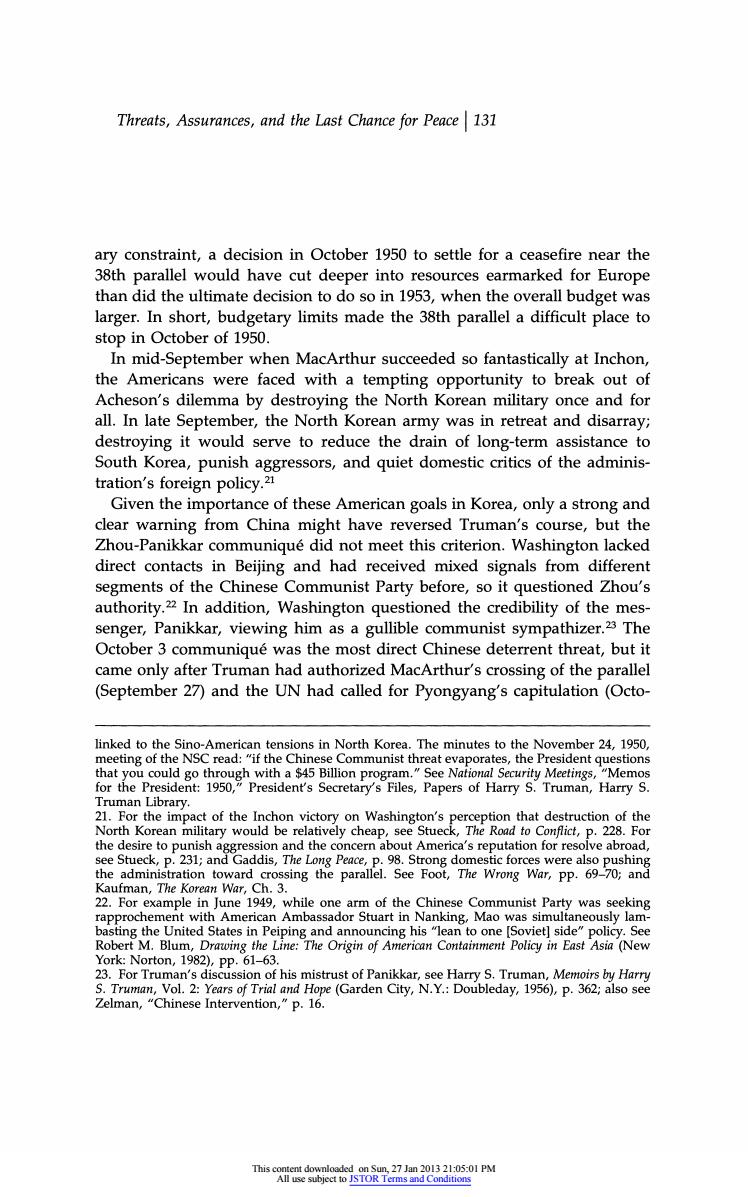正在加载图片...

Threats,Assurances,and the Last Chance for Peace 131 ary constraint,a decision in October 1950 to settle for a ceasefire near the 38th parallel would have cut deeper into resources earmarked for Europe than did the ultimate decision to do so in 1953,when the overall budget was larger.In short,budgetary limits made the 38th parallel a difficult place to stop in October of 1950. In mid-September when MacArthur succeeded so fantastically at Inchon, the Americans were faced with a tempting opportunity to break out of Acheson's dilemma by destroying the North Korean military once and for all.In late September,the North Korean army was in retreat and disarray; destroying it would serve to reduce the drain of long-term assistance to South Korea,punish aggressors,and quiet domestic critics of the adminis- tration's foreign policy.21 Given the importance of these American goals in Korea,only a strong and clear warning from China might have reversed Truman's course,but the Zhou-Panikkar communique did not meet this criterion.Washington lacked direct contacts in Beijing and had received mixed signals from different segments of the Chinese Communist Party before,so it questioned Zhou's authority.22 In addition,Washington questioned the credibility of the mes- senger,Panikkar,viewing him as a gullible communist sympathizer.23 The October 3 communique was the most direct Chinese deterrent threat,but it came only after Truman had authorized MacArthur's crossing of the parallel (September 27)and the UN had called for Pyongyang's capitulation(Octo- linked to the Sino-American tensions in North Korea.The minutes to the November 24,1950 meeting of the NSC read:"if the Chinese Communist threat evaporates,the President questions that you could go through with a $45 Billion program."See National Security Meetings,"Memos for the President:1950,"President's Secretary's Files,Papers of Harry S.Truman,Harry S. Truman Library. 21.For the impact of the Inchon victory on Washington's perception that destruction of the North Korean military would be relatively cheap,see Stueck,The Road to Conflict,p.228.For the desire to punish aggression and the concern about America's reputation for resolve abroad, see Stueck,p.231;and Gaddis,The Long Peace,p.98.Strong domestic forces were also pushing the administration toward crossing the parallel.See Foot,The Wrong War,pp.69-70;and Kaufman,The Korean War,Ch.3. 22.For example in June 1949,while one arm of the Chinese Communist Party was seeking rapprochement with American Ambassador Stuart in Nanking,Mao was simultaneously lam- basting the United States in Peiping and announcing his"lean to one [Soviet]side"policy.See Robert M.Blum,Drawing the Line:The Origin of American Containment Policy in East Asia (New York:Norton,1982),pp.61-63. 23.For Truman's discussion of his mistrust of Panikkar,see Harry S.Truman,Memoirs by Harry S.Truman,Vol.2:Years of Trial and Hope (Garden City,N.Y.:Doubleday,1956),p.362;also see Zelman,"Chinese Intervention,"p.16. This content downloaded on Sun,27 Jan 2013 21:05:01 PM All use subject to JSTOR Terms and ConditionsThreats, Assurances, and the Last Chance for Peace j 131 ary constraint, a decision in October 1950 to settle for a ceasefire near the 38th parallel would have cut deeper into resources earmarked for Europe than did the ultimate decision to do so in 1953, when the overall budget was larger. In short, budgetary limits made the 38th parallel a difficult place to stop in October of 1950. In mid-September when MacArthur succeeded so fantastically at Inchon, the Americans were faced with a tempting opportunity to break out of Acheson's dilemma by destroying the North Korean military once and for all. In late September, the North Korean army was in retreat and disarray; destroying it would serve to reduce the drain of long-term assistance to South Korea, punish aggressors, and quiet domestic critics of the administration's foreign policy.21 Given the importance of these American goals in Korea, only a strong and clear warning from China might have reversed Truman's course, but the Zhou-Panikkar communique did not meet this criterion. Washington lacked direct contacts in Beijing and had received mixed signals from different segments of the Chinese Communist Party before, so it questioned Zhou's authority.22 In addition, Washington questioned the credibility of the messenger, Panikkar, viewing him as a gullible communist sympathizer.23 The October 3 communique was the most direct Chinese deterrent threat, but it came only after Truman had authorized MacArthur's crossing of the parallel (September 27) and the UN had called for Pyongyang's capitulation (Octolinked to the Sino-American tensions in North Korea. The minutes to the November 24, 1950, meeting of the NSC read: "if the Chinese Communist threat evaporates, the President questions that you could go through with a $45 Billion program." See National Security Meetings, "Memos for the President: 1950," President's Secretary's Files, Papers of Harry S. Truman, Harry S. Truman Library. 21. For the impact of the Inchon victory on Washington's perception that destruction of the North Korean military would be relatively cheap, see Stueck, The Road to Conflict, p. 228. For the desire to punish aggression and the concern about America's reputation for resolve abroad, see Stueck, p. 231; and Gaddis, The Long Peace, p. 98. Strong domestic forces were also pushing the administration toward crossing the parallel. See Foot, The Wrong War, pp. 69-70; and Kaufman, The Korean War, Ch. 3. 22. For example in June 1949, while one arm of the Chinese Communist Party was seeking rapprochement with American Ambassador Stuart in Nanking, Mao was simultaneously lambasting the United States in Peiping and announcing his "lean to one [Soviet] side" policy. See Robert M. Blum, Drawing the Line: The Origin of American Containment Policy in East Asia (New York: Norton, 1982), pp. 61-63. 23. For Truman's discussion of his mistrust of Panikkar, see Harry S. Truman, Memoirs by Harry S. Truman, Vol. 2: Years of Trial and Hope (Garden City, N.Y.: Doubleday, 1956), p. 362; also see Zelman, "Chinese Intervention," p. 16. This content downloaded on Sun, 27 Jan 2013 21:05:01 PM All use subject to JSTOR Terms and Conditions